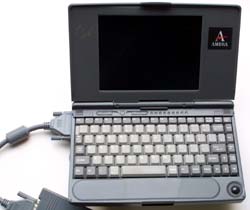Installing Slackware Linux on the Ambra SN8660
HOME > Computers > Ambra
About the machine
 The Ambra SN8660 is a notebook computer with a 25MHz 486 processor.
It was sold by
IBM,
at a time when Ambra was an IBM brand name; the
technical specifications
are still available on the IBM web server.
It's smaller than a standard laptop, but not as small as, say, the
Toshiba Libretto
(which also runs Linux).
In fact, it's similar in size to the
HP
OmniBook 800.
The
LCD screen is monochrome,
VGA
resolution.
The Ambra SN8660 is a notebook computer with a 25MHz 486 processor.
It was sold by
IBM,
at a time when Ambra was an IBM brand name; the
technical specifications
are still available on the IBM web server.
It's smaller than a standard laptop, but not as small as, say, the
Toshiba Libretto
(which also runs Linux).
In fact, it's similar in size to the
HP
OmniBook 800.
The
LCD screen is monochrome,
VGA
resolution.
There's considerable variation in pointing devices for machines of this
class; the OmniBook has a tiny pop-out mouse on a pivoting lever,
while the Libretto has a thumb-operated mouse on the lid, beside
the screen.
The Ambra has a small trackball in the bottom right-hand corner, with
two buttons on the outside of the case.
It appears to the
OS
as a
PS/2-style
mouse.
The disk in the Ambra is only 170Mb.
Installing Linux
In general, one can install Linux from floppy disk, CD-ROM, or via
a network.
In this case, I have no CD-ROM drive for the machine, so that rules
out one of the easier methods.
A network install, of course, requires a network interface such as
ethernet.
The Ambra has no built-in ethernet, but I do have an Etherlink
PCMCIA
card (and cable).
However, the small-memory Slackware installation disk does not
include PCMCIA drivers.
Installing the drivers just takes up too much memory, causing the
installation to fail.
So, I made myself a set of Slackware 7.0 installation floppy disks.
Getting Slack onto the Ambra
Only one way to do it: floppy disks.
The Result
I have a handy, small Linux machine that can act as a Telnet host
or serial terminal.
It runs at a whopping 12.47
BogoMIPS, which is about right
for a 25MHz 486.
 The Ambra SN8660 is a notebook computer with a 25MHz 486 processor.
It was sold by
IBM,
at a time when Ambra was an IBM brand name; the
technical specifications
are still available on the IBM web server.
It's smaller than a standard laptop, but not as small as, say, the
Toshiba Libretto
(which also runs Linux).
In fact, it's similar in size to the
HP
OmniBook 800.
The
LCD screen is monochrome,
VGA
resolution.
The Ambra SN8660 is a notebook computer with a 25MHz 486 processor.
It was sold by
IBM,
at a time when Ambra was an IBM brand name; the
technical specifications
are still available on the IBM web server.
It's smaller than a standard laptop, but not as small as, say, the
Toshiba Libretto
(which also runs Linux).
In fact, it's similar in size to the
HP
OmniBook 800.
The
LCD screen is monochrome,
VGA
resolution.